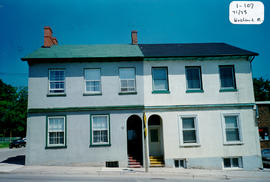- CA BWGPL GJ-HB-2017-03-20-05
- Pièce
- 1995
Fait partie de George Jackson fonds
The house located at 39 Drury St. (at the southeast corner of Drury and Thomas Streets) was built pre-1900 in the Ontario Vernacular Cottage style. Bob (“Red”) Armstrong, a bachelor, once lived here. Jim Webb eventually bought the property and rented the structure to Victor Hunter (a carpenter) and his family. Frank Park (a handyman) kept his horse in the small barn on the property. Charles Hounsome (a railway section man) also lived here at one time. Lloyd Houston (a butcher) and his wife Jean lived here after the wars.
The one-storey, three-bay cottage has a shallow-pitched, gable roof, a symmetrical façade, and a rectangular plan with a centre hall. A box hall was typical for this style. The simple entrance has a single door set into a rectangular opening. It opens directly into the house from grade level and there is no porch (or weather protection) to shelter the entrance. The windows have low floor to ceiling heights. There are double-hung, 2/2 windows on either side of the entrance that appear to be original. They are set into simple, rectangular openings with plain, wood frames and sills. Wood frame construction is covered with vinyl siding. The original cladding was wood. The house has a parged, stone foundation. There is a single, brick masonry chimney at the centre of house. According to the 2000 inventory, this simple cottage probably had few decorative details originally. It also notes that the concrete block chimney on the exterior south wall is a later addition. (1, 2, 3)
Sans titre



